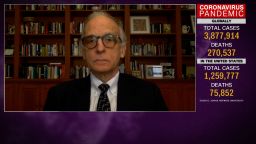Editor’s Note: Kent Sepkowitz is a physician and infectious disease expert at Memorial Sloan Kettering Cancer Center in New York. The views expressed in this commentary are his own. View more opinion on CNN.
A flurry of recent scientific articles suggests that a major puzzle in Covid-19 pandemic control – determination of who is and who is not immune – may soon be solved. Researchers in Asia and the US have shown promising results in the measurement of how well our T-cells, the more elusive half of the human immune response, are equipped to handle coronavirus infection.

Such insight is certain to give serenity now to many people – while rattling others. It also will upgrade our understanding of just how SARS-CoV-2 has evaded both disease-induced and vaccine-induced immunity with such startling swiftness.
Two and a half years and several waves in, we have two subvariants, Omicron BA.4 and BA.5, moving easily across large groups who have been vaccinated and/or had previous infection. Thankfully, previous immunity results in a much less severe infection for most people. But the virus continues to circulate worldwide with hundreds of thousands of new cases diagnosed daily.
So, what gives? Whatever happened to real immunity, the type where you don’t just get a milder infection, you don’t get disease at all? When you get a measles shot, for example, you never get measles. Period. And why haven’t the same remarkable scientists who have given us rapid diagnostic tests, life-saving vaccines and effective therapies been able to sort out just exactly what we are talking about when we talk about immunity?
Well, it’s complicated. Really complicated. The field of immunology has been a scientific wild frontier since its inception a little more than a century ago. It certainly started with a big bang, with the original insights resulting, in 1908, in a Nobel Prize.
Right now, at least in the context of Covid-19, many think of the immune system as having two main components: antibodies, which can prevent an infection sinking into the tissue, and T-cells, a type of white blood cell that are tasked with grinding down an already established infection. The system is much more complex but focusing on these two pillars is helpful to understand the challenges ahead.
Thus far in the pandemic, our antibody repertoire has not been up to the task – witness wave after wave of disease, even among those with previous disease and/or vaccination. What has worked well has been our immune system’s prevention of serious disease, a central job of the engulfing T-cells.
With Covid-19, scientists first focused on measuring antibody levels, a relatively simple and familiar approach. Antibodies are floating in the bloodstream so that a simple tube of blood can be used to determine levels. The problem is that the body makes more than one antibody per pathogen; it is not a yes or no situation. Rather, an antibody might be produced against a section of the coronavirus spike protein or a corner of the viral envelope or its core proteins or somewhere else altogether.
Our portfolio of identified antibodies resembles the old story of several blind men touching the elephant with each describing a different part yet missing the whole. Because the implications of a test result are uncertain, the US Centers for Disease Control and Prevention do not recommend routine antibody testing.
Our ability to measure the other main part of the immune response – the T-cell side – requires a much slower and more sophisticated lab set-up owing to the way the T-cell works. On first meeting a specific infection, the T-cell is unfamiliar (“na?ve”) and slow to attack; but on subsequent meetings, it has “memory” so that it can quickly and efficiently go about its destructive business.
In the lab, researchers stimulate the T-cell by presenting it with “bait” – a scrap of the infectious particle or a lab-built, synthetic string of mini-proteins (called peptides). If the T-cell recognizes the bait, it fiercely prepares to attack it. If the bait is not recognized, the T-cell shrugs and moves on.
Up to now, measuring this stimulation (also referred to as “activation”) of the T-cell has been difficult. Blood samples must be rapidly processed and specific cells separated out. This sort of testing took experts days to perform – one patient at a time. Broad-scale testing – the type that public health experts need to inform decisions – was impossible.
But as we have seen throughout the pandemic, desperation has proven the mother of invention. And now, several groups working apart and together, appear ready to introduce exactly what is needed: a simple(ish), rapid and relatively cheap way to measure whether a person’s T-cells have enough oomph to protect the person from serious consequences of the next infection. This in turn would directly influence vaccination, boosting and perhaps even social distancing strategies.
The latest advance hinges on a simple adjustment regarding what to measure. Rather than observe the behavior of the T-cells, scientists can measure the various chemical products the T-cell spits out after being stimulated. The more chemical (a group of “cytokines” or “chemokines”) produced, the more equipped the T-cell is to seek and destroy the specific infection.
These new tests, if as good as advertised (always a big “if”), will indeed help us pick our way through the months ahead as we prepare for another surge and think about the optimal way to deploy both the current array of vaccines and – hopefully – the coming generation of more Omicron-focused products. In a best-case scenario, these novel tests could be adapted to determine if someone is “safe” to be around whatever the latest variant or subvariant might be.
Get our free weekly newsletter
Such availability though likely is not around the next corner. Though the work presented thus far may help public health officials determine how best to deploy resources, they will not yet provide the answer for a worried individual to the basic question: am I protected? Our tests right now, even with the latest addition, simply are not accurate enough. The question is particularly pressing for those with abnormal immune systems.
Furthermore, this big, essential step forward comes with a crucial caveat. Thus far during the pandemic, each bit of progress has been accompanied by a sigh of relief that “we are almost out of the pandemic” that results in corner-cutting and the urge to proclaim victory. Rather, this is only yet another tool to help us understand just when – or if – such a victory can confidently be claimed.

